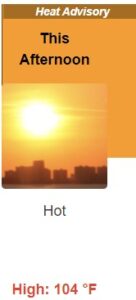
Sizzling heat has begun early this summer in Texas. This is evident from the salt lines on my black tee-shirt at the end of the day after helping clients with forklift observations. Most manufacturing companies have warehousing and shipping employees working in areas that are not air-conditioned. Some companies also perform production operations areas with no AC. We are blessed to not have to deal with working in the sun much.
In addition to the deaths of children in hot cars, and some August football practices that are reported on the news, we are still having 30-60 work-related heat illness deaths each year in the U.S. Of course, there are way more cases of heat illness on-the-job where no-one dies happening as well.
It’s critical that each manufacturer put preventive measures to prevent heat illnesses in place now. I’ve listed some common and effective best practices below to get you started:
- Have a specific person in each building (with no AC) assigned to monitor the effective temperature, and to communicate risk levels and appropriate actions to supervisors/employees. If you have open docks and your building doesn’t super-heat, you can download and use the NIOSH Heat Index app to monitor conditions.
- Supply endless cold water for workers. You might consider an ice machine, refrigerated cooling station, or construction cooler with a spicket). On days where the effective temperature is above 95 F, also supply electrolyte drink (Be sure to educate people to always drink a water before having more sports drink).
- Ensure there are adequate fans where people spend most of their time. (You might even consider putting a magnet-mounted fan on forklifts).
- Adjust work planning to fit the situation. Try to do the most physically demanding work in the mornings when possible.
- Adjust breaks to fit the situation. Make sure there is an air-conditioned area where workers are welcome rest during breaks. Consider declaring extra quick breaks in very hot afternoons when there is a lot of very physical work happening or temperature/humidity are very stressful.
- Some companies might offer or encourage evaporative cooling neck gators or towels to workers.
- Assign people working together to be “Heat Buddies” where they check on each other to ensure they feel OK and that they are drinking liquids throughout the shift.
- Enact a "Heat Acclimation" process where new and returning employees are questioned about their current state of heat acclimatization. If deemed appropriate, the worker will be partially limited in strenuous work time allowed will be assigned a maximum stretch of hours allowed without a break. These restrictions can be reduced every couple of days during their first two weeks
- Train workers on risk factors for heat stress, preventing heat stress, how to recognize and respond to heat illnesses.
OSHA started a National Emphasis Program this year where they will be conducting targeted audits in industries that have higher likelihood of heat stresses. The list of targeted industries includes paper distribution companies and chemical industries (such as ink companies or rubber roller manufacturers), but printing companies were not on the list. However, when OSHA is at a printing company, they will likely investigate the process the company has in place to protect employees from heat illness through the summer.
Keep Hydrating My Friend,
Joe Eudy
President

Impact Safety has been serving manufacturers in Texas since 2005. My goal is to help clients build and maintain pro-active safety programs that employees are proud to participate in. The COVID era encouraged me to build on-line training options for clients, and soon these will be offered nationally. For more information on our services go to www.safeimpact.com or message Joe at [email protected].

![]()
